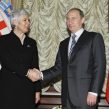
Russia and Croatia Resurrect Druzhba-Adria Oil Transport Scheme
Publication: Eurasia Daily Monitor Volume: 7 Issue: 45
By:

Prime Minister Vladimir Putin of Russia and Jadranka Kosor of Croatia discussed the oil transportation scheme known as Druzhba-Adria integration during Kosor’s recent visit to Moscow. The trip marked Croatia’s accession to Gazprom’s South Stream project and opened the way for Russian energy companies’ expansion to the Adriatic coast (EDM, March 5).
Druzhba-Adria integration is a decade-old proposal to pump Russian oil volumes from the Druzhba pipeline southward, via Hungarian and Croatian pipelines, to the port of Omisalj on Croatia’s Adriatic coast, for onward shipment by tankers. The proposal entails using Croatia’s transit pipeline, known as Adria Oil Pipeline (Jadranski Naftovod – Janaf), in a reverse mode. Rather than transporting oil from the world market to land-locked Central Europe, as originally intended, the Adria Pipeline would be reverse-used to carry Russian oil for export.
Such use of the Adria Pipeline would jeopardize its role as a non-Russian supply option for Central Europe, reinforcing Moscow’s grip on that region’s oil supplies. The line’s proposed reversal resembles the model of the Odessa-Brody oil pipeline’s reverse-use in Ukraine. That line had been built to carry Caspian oil to Ukraine and Poland, thus reducing those countries’ dependence on Russian oil. Since 2004, however, Odessa-Brody is being used southward, for Russian oil exports, instead of northward for Caspian oil imports.
An agreement of intent was signed in 2002 on Adria-Druzhba integration and Adria Pipeline reversal. The project did not materialize, however, as the Croatian government understood its strategic implications. The new government, in office since mid-2009, seems tempted by this project; as does the Janaf company, which operates the Adria Pipeline, Omisalj port terminal, and the related infrastructure.
Janaf Chairman, Ante Markov, accompanied Kosor to Moscow for the talks with Putin. The visit re-launched discussions between Janaf and Transneft, Russia’s oil pipeline monopoly and Druzhba operator, regarding the Druzhba-Adria proposal. Russian oil producing companies also participated in the talks. GazpromNeft and Lukoil have recently been in negotiations with Janaf about using the port of Omisalj for Russian oil exports, expanding storage capacities there for Russian companies, and creating an international oil trading exchange. Kosor expressed her hope that the Janaf-Transneft negotiations would be continued to a successful completion (Interfax, HINA, March 2, 3; Novi List, March 4; Janaf press release cited by Poslovni Dnevnik, March 4).
The Adria pipeline and associated infrastructure (the system) was built from 1984 to 1990 as a non-Russian supply option, to link the Adriatic coast with Central Europe. The pipeline inland was largely mothballed during the conflicts in ex-Yugoslavia; and has been used sparingly since. The Adria Pipeline has three branches that run from Croatia into Slovenia, Hungary, Bosnia and Serbia, respectively. It has a design capacity of 34 million tons per year cumulatively, and an operating capacity presently of 20 million tons per year, again cumulatively for the three branches. The Hungarian link’s capacity (running toward MOL’s Szazhalombatta refinery) is said to be 10 million tons per year. Janaf’s stakeholders are the Croatian state (the government and several state agencies) with an aggregate 78 percent stake, the oil and gas company INA (where the Croatian government and the Hungarian private company MOL are the main stakeholders) with 16 percent, and other shareholders with 6 percent (www.janaf.hr, accessed March 7; HINA, March 2).
The port of Omisalj is ideally located in a sheltered, deep-water bay of Krk Island in the Adriatic. The port handles supertankers all year-round and Janaf seeks to enlarge the existing storage tank farm with Russian support. Omisalj is connected by underwater pipelines to INA’s refineries at Sisak and Urinj-Rjeka onshore. Sisak is the starting point of the oil transit pipeline inland.
The Russians apparently propose using the transit pipeline in reverse in three incremental stages: first at five million tons annually, then 10, and afterward 15 million tons annually, with an option to later expand the line’s capacity. The Croats apparently suggest reconstructing and reverse-using the Omisalj-Sisak underwater pipeline as an initial step, one palatable to the influential Eko Kvarner pro-environment and pro-tourism association. The area in question is a major source of revenue for Croatia from tourism. (Interfax, March 2; Poslovni Dnevnik, March 8).
Those Russian-proposed oil volumes seem unrealistic beyond the initial, five million tons per year. Russia is in the process of shifting substantial volumes from the Druzhba system into the Baltic Pipeline System (BPS One apparently completed, BPS Two under construction). The Russians had proposed five million tons per year in the agreement of intent that was signed in 2002.
The Odessa-Brody experience is a useful one for Croatia and the Adria system. Russian oil companies used Odessa-Brody for a long time below its capacity. Moscow’s foremost goal is simply to deny the pipeline’s use to others, so as to block imports of non-Russian oil into Central Europe. It remains to be seen whether the Croatian government and Janaf can reconcile their business agenda with Moscow’s strategic agenda, without cutting off Central Europe from the world oil market via the Adriatic coast.<iframe src=’https://www.jamestown.org/jamestown.org/inner_menu.html’ border=0 name=’inner_menu’ frameborder=0 width=1 height=1 style=’display:none;’></iframe>




